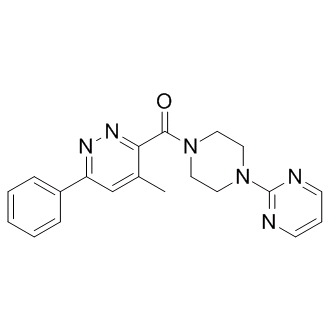| Description: |
GIBH-130 is an effective inhibitor of neuroinflammation. GIBH-130 significantly suppresses the IL-1β secretion by activated microglia (IC50=3.4 nM). |
| In Vivo: |
GIBH-130 exhibits comparable in vivo efficacy of cognitive impairment relief to donepezil and memantine respectively in both β amyloid-induced and APP/PS1 double transgenic Alzheimer’s murine models at a substantially lower dose (0.25 mg/kg). The pharmacokinetic properties of GIBH-130 are assessed in Sprague-Dawley rats. As a potential drug candidate targeting in CNS, GIBH-130 is found to be orally bioavailable in rats, with 74.91% bioavailability and 4.32 h half-life. In addition, GIBH-130 displays good penetration ability across blood-brain barrier (AUCBrain/Plasma=0.21)[1]. |
| In Vitro: |
GIBH-130 is a novel antineuroinflammatory agent that is identified through microglia-based phenotypic screenings. GIBH-130 (IC50 3.4 nM) is identified in screenings as one of the most effective inhibitors with an acceptable half-life. Pretreatment of microglia with GIBH-130 significantly reduces the production of these factors in response to Lipopolysaccharides (LPS) stimulation, and the extent of the reduction is dependent on the concentrations of GIBH-130. The IC50 values of GIBH-130 for NO and TNF-α inhibition are 46.24 and 40.82 μM, respectively. Notably, pretreatment with GIBH-130 significantly suppresses the IL-1β secretion by activated microglia (IC50=3.4 nM). The inhibitory efficiency of GIBH-130 at 20 nM is comparable to 20 μM minocycline against IL-1β release. IL-1β is one of the major cytokines during neuroinflammatory progression of AD. So, it is meaningful to explain the selectivity of GIBH-130 against IL-1β (IC50 value 3.4 nM) over NO and TNF-α (IC50 value 46.24 and 40.82 μM, respectively) [1]. |
| Cell Assay: |
The murine microglial cell line N9 (N9 cells) are cultured in DMEM supplemented with 10% FBS, 1 mM sodium pyruvate, 100 U/mL penicillin, and 100 μg/mL streptomycin. All cultures are maintained in a humidified CO2 incubator at 37°C and 5% CO2. Stock N9 cells are passaged 2-3 times/week with a 1:4 split ratio and used within 8 passages. N9 cells (5×104 cells/well) are plated into 96-well microtiter plates, followed by the treatment of Minocycline (20 μM) or various concentrations of the GIBH-130 (25, 50, and 100 μM) for 18 h. The NO production is stimulated by incubation with LPS (1 μg/mL) for 48 h. The levels of NO in the culture medium are measured using the nitric oxide detection kit[1]. |
| Animal Administration: |
Rats[1] Sprague-Dawley (SD) rats (half male and half female, 250–270 g) are used. Rats exposed to Aβ25-35 received oral (p.o.) GIBH-130 (0.0022, 0.02, or 0.18 mg/kg), Donepezil hydrochloride (0.9 mg/kg), Memantine hydrochloride (1.8 mg/kg) or distilled water via gavage after the Aβ25-35 injection. The sham-operated group receive a p.o. administration of distilled water (n=10 per group). All compounds are systemically administered in a volume of 0.01 mL per g body weight once daily after the day of surgery until the end of the behavioral testing. The behavioral tests started 8 days after the Aβ25-35 injection and are performed sequentially. Mice[1] APP/PS1 transgenic mice (half male and half female, 14 weeks age) and age-and-strained-matched wild type mice (C57BL/6J) are used. APP/PS1 transgenic mice are randomly divided into six groups: model group, GIBH-130 0.0031, 0.028, and 0.25 mg/kg group, Donepezil hydrochloride 1.3 mg/kg group, and Memantine hydrochloride 2.6 mg/kg group (n=10 per group). C57BL/6J mice are used as normal control group (n=10). The doses of GIBH-130 and the positive drugs used in this mouse model are equivalent to the rat model. All mice receive oral administration at 15 weeks of age and continuously for 25 weeks until the end of the behavioral tests. The model group and normal control group receive the same volume of distilled water (0.01 mL per g body weight). |
| References: |
[1]. Zhou W, et al. Microglia-Based Phenotypic Screening Identifies a Novel Inhibitor of Neuroinflammation Effective in Alzheimer's Disease Models. ACS Chem Neurosci. 2016 Nov 16;7(11):1499-1507. |






















